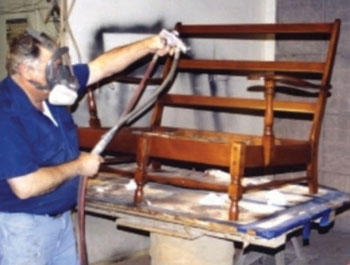 |
In recent years, a number of so-called âsuperâ high-performance coatings have been taking over the wood finishing industry. But what, exactly, are they? This will give you a quick overview, with some information about one of the most popular ones, conversion varnish.
All of the super coatings are reactive, which in essence means that these chemically improved coatings will not dissolve once they are fully cured. They become very hard and are extremely durable and chemical-resistant to most household products.
The coatings are known generally as âpost-catsâ because they are catalyzed just before they are sprayed, while the âpre-catalyzedâ lacquers â which are not comparable to any of the super coatings â as a rule are catalyzed during the manufacturing process and then shipped.
However, recently some manufacturers have stopped adding the catalyst into the lacquer coating and are sending the catalyst along with the coating to allow the finisher to add it into the coating just before he starts to spray.
Conversion varnish is a coating that contains a synthetic alkyd resin, plus several solvents and an acid catalyst. When these components are mixed together, the result is a chemical reaction that triggers the molecules to start to crosslink. This means that the molecules in these chemicals become larger in size and start to overlap each other, which causes the coating to crosslink and chemically cure.
The main features of a conversion varnish are:
⢠They contain more than 60 percent high solids.
⢠They are water white, crystal clear and non-yellowing coatings.
⢠They have good UV-resistance.
⢠They are fast drying.
⢠They wear well.
⢠They are low in formaldehyde and volatile organic compounds (VOCs).
⢠They are free of hazardous air pollutants (HAPS).
One coat of conversion varnish can equal four coats of some of the single coatings. This allows you to do high-build finishes with fewer coats, and that attribute alone can save finishers a lot of time, labor and money.
How to Use Them
Usually, a vinyl sealer is used first to seal the wood and protect against high- moisture areas, like around a kitchen sink or bathroom vanities. Once the sealer has dried, the conversion varnish is catalyzed, using the proper amount of catalyst.
It is important to catalyze only enough coating needed for the work ready to finish at hand. Any excess coating that is not used may not be saved for another day. It also is important to follow exactly the instructions of the material supply company.
Conversion varnish is used by many furniture, kitchen cabinet and bathroom vanity manufacturers and by architectural finishing shops for interior woodwork, although they may also use one of the other super coatings for certain applications. If you are looking for a coating that is very hard, extremely durable, chemical-resistant and water clear, conversion varnish may be your answer. But follow the caveats listed above to ensure problem-free results.
Source: Mac Simmons, a freelance writer and 50-year veteran of the furniture finishing, refinishing and restoration trades. For past articles, visit WoodworkingNetwork.com or write Mac Simmons, Box 121, Massapequa, NY 11758.




Have something to say? Share your thoughts with us in the comments below.